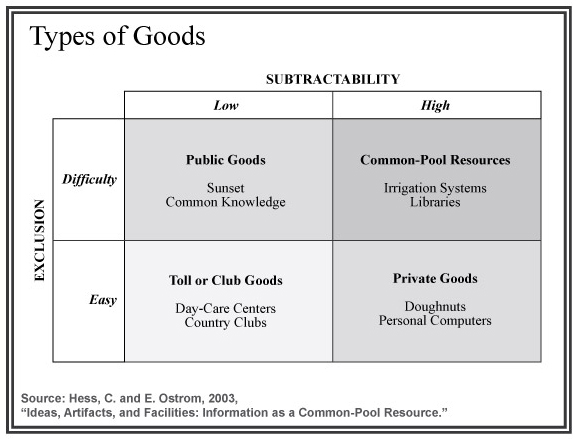“Free as in free speech, not as in free beer,” the slogan of free software advocate Richard Stallman, illustrates the distinction between goods that are naturally scarce (beer) and those that are naturally abundant (speech).
The topic of scarcity versus abundance was discussed by David Bollier in the interview I posted yesterday and is clarified in the figure below, reprinted from an October 2010 post on P&P (“Four types of goods”).

“There are two sets of important distinctions about goods, and they make four cross-classifications. Goods can be either rival or non-rival, and they can be either excludable or non-excludable,” writes Herman Daly in the essay, “Sustaining Our Commonwealth.”
What Daly calls rivalrousness is here written as subtractability: the extent to which one person’s use physically diminishes or precludes another’s.
Excludability (or exclusion) is a legal concept: the ease of precluding others, through defined rights or norms of ownership or use.
In “Ideas, Artifacts, and Facilities: Information as a Common-Pool Resource” (pdf), Charlotte Hess and Elinor Ostrom describe this distinction as the nature of goods (subtractability) versus the nature of property regimes (exclusion). They call it one of “four basic confusions that need to be untangled.” The other three are: (1) the distinction between resource systems and the flow of resource units; (2) the distinction between common property and open-access regimes; and (3) distinctions among the types of property rights involved in “ownership.”
Ostrom presented an earlier draft of this paper at the seminal 2001 Conference on the Public Domain, which included talks by James Boyle, Yochai Benkler, Lawrence Lessig, Eben Moglen, Carol Rose, Jessica Litman, Pamela Samuelson, and John Perry Barlow (video downloads available).
See also: Wikipedia on public goods and Paul Hartzog on technology and types of goods.

